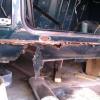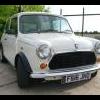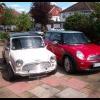I often read / hear criticism of Austin / BL / Rover etc because they didn't significanlty update the mini design throughout it's long life. Sure, there were changes, but fundementally the car remained the same.
Whilst I guess you can't deny that this is the case, I find myself of mixed opinion as to whether that was a good or bad thing. I have a '92 Cooper, and I love the fact that it is still essentially ' a mini' - most onlookers also regard it as an old fashioned mini, and sometimes people are even confused about it's age (I guess they don't notice the reg plate). So for me, I am glad that the car remained largely unchanged, as it means that I can own a 'proper' mini regardless of whether it is a 60's car or a 90's car.
What do others think? What would the mini 'scene' be like if they had revised the car - say along the lines of the fiesta, which has changed hugely over the years. Would we really have such a large scene, or would the original mini just be like any other classic, in the world of the stereotypical classic car owner (as Jeremy Clarkson would say, anorak wearing adenoidal type people).
Would the mini even have continued to be popular if they had revised the design over the years? Or would they have sooner or later come out with a variant which was basically rubbish, and ruined the brand?
Discuss ! ![]()




























